Rite of Spring
Saturday was an important festival in the Japanese Calendar: Setsubun marks the start of Spring and the day when the evil spirits are banished. Traditionally, in a household with children, the father will dress up as a demon and the children will throw dried beans at him to ward off the bad spirit, until they return the following year.
Kyoto is one of the best places to be for this festival and within Kyoto the Yoshida temple is a highlight, which happens to be 15 minutes walk from where I'm staying. It was packed with people and stalls selling all manner of local delicacies. 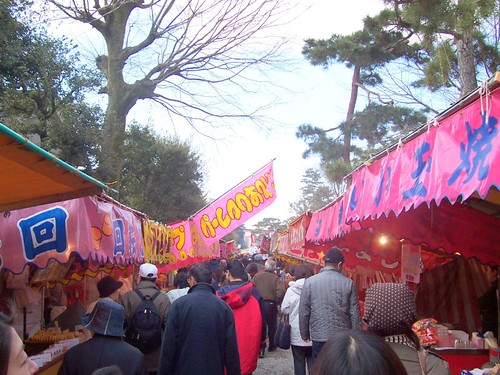
Within the temple itself people prayed and received blessings from the monks, and a huge bonfire was in the final stages of construction. 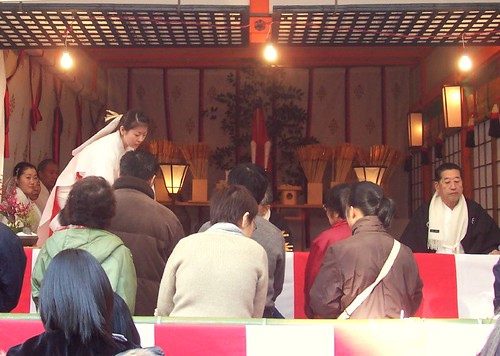
The Japanese like to burn things; Due to lack of space there are very few land-fill sites and so virtually all waste is incinerated (something which has currently caused political unrest in an outlying town to Kyoto where a brand new incinerator has recently been opened). The bonfire at the shrine was not, however, for burning household rubbish. Throughout the year people come to the shrine and inscribe their wishes, either on pieces of paper which are attached to tree branches, or on blocks of wood, in the hope that Buddha will grant these blessings. 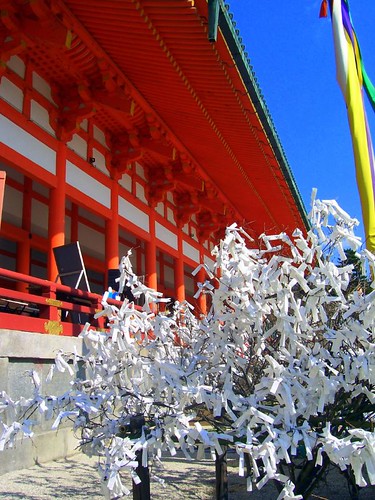
At the end of the year, whether these wishes have been fulfilled or not, the wooden blocks should not simply be thrown in the bin, hence the fire which is used to burn the now defunct prayer tokens.
Near Yoshida shrine is the Heian temple where we walked to see what promised to be the highlight performance of the day. The temple is stunning and because we had some time before the show, we walked around the very beautiful and equally empty temple gardens.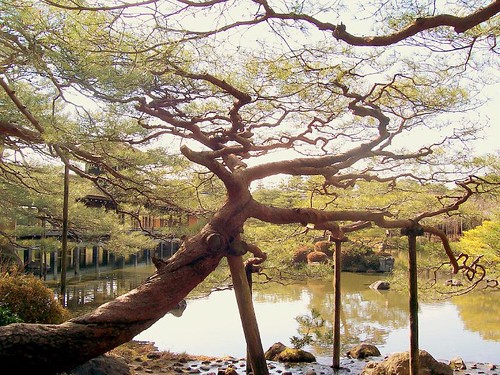
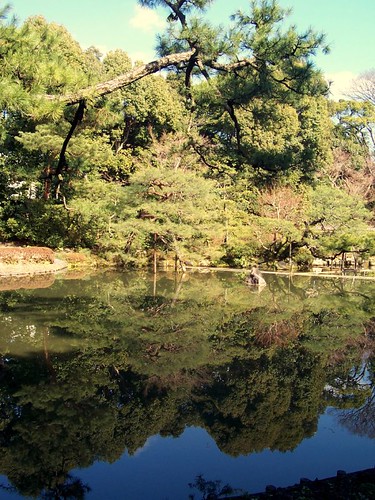
We also watched a short play in one of the temple side-buildings. Though it was modern theatre and, I presume, an amateur company, some of the traditional aspects of Japanese drama are still firmly entrenched. Having been completely spellbound watching the Kabuki theatre last year at the Kabuki-za in Tokyo, I was hoping to go and see the local speciality next weekend. Noh theatre is supposed to be rather harder to follow than Kabuki. I sat through and enjoyed the Kabuki performance last year because I had an audio commentary in an ear-piece which explained every aspect of what was happening, from the costumes, stories, history and actors to the alien music and the cries from the audience throughout the performance - this is really highly recommended, but pay the extra for the electronic commentary, otherwise you will be bored within half an hour (of the total five hour performance). Unfortunately the Noh theatre here does not have audio commentary so if I can't find a translation of the performances I'll probably have to give this a miss. A return to Kabuki in Tokyo will not be a bad second choice.
Anyway, the modern drama was short, pretty confusing and moderately enjoyable. It was however free and as I was sat drinking a warm, mildly alcoholic rice-porridge drink (perhaps the Japanese equivalent of mulled wine) it was a pleasant place to spend half an hour.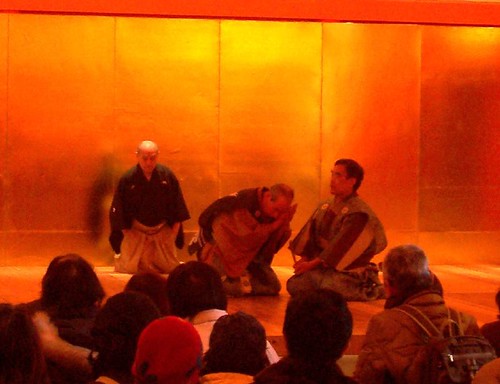
The central performance was in the main forecourt of the temple and, cordoned off by ropes and surrounded by onlookers, the stage was set with various props placed around the arena. Local dignitaries sat within the stage watching from prime position. Seven monks appeared, dressed in yellow garbs with white veils around their mouths, and opposite them were three warriors each with a child, carrying various weapons, in tow. (Any analysis of the events from me is speculation as I've little idea of what was really going on). 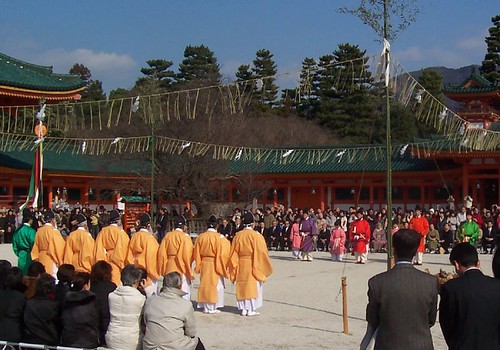
At this stage Evil showed up, face covered with a multi-eyed mask and followed by more children, this time carrying flaming torches. The children were extremely young and had some considerable difficulty keeping the flaming torches not only upright but also away from each other. It seems common sense that making your shoes out of the same material as your torches is not great planning. Anyway, I waited with baited breath for one of them to set alight to their neighbour as they waved the flames around and bits of torch scattered the ground in the wind, but none ignited. 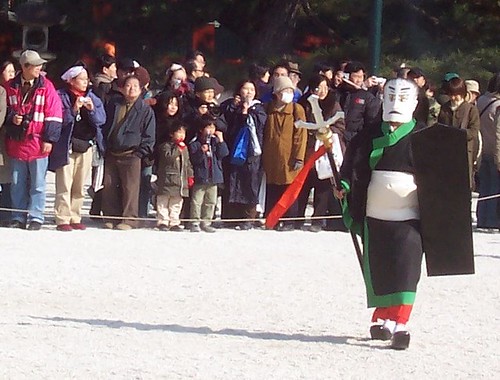
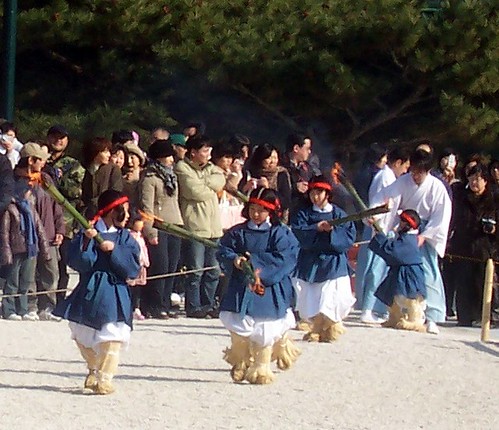
Evil then marched to centre stage and was held off by the warriors, the first one firing arrows (not terribly pointy, but arrows nonetheless) into the crowd, the second one fighting with a stick. The method of the third eludes me. With interludes of talking and chanting, the players and dignitaries circled the arena several times, Evil chanting 'evil' and the rest replying with 'evil, be gone, good luck, come in'. After several times around they headed out to the front of the temple where the chanting continued.
It seemed that this was the climax and having watched for some time we headed back to Yoshida shrine for local refreshments.
This all took up a good few hours of the day so I headed back for a quick nap to catch up from the previous night. Later on I headed out for dinner alone doing the usual trick of trying to decide which restaurant will be good as well as having a reasonable chance of my being able to order something not outrageously expensive. Eventually I stumbled upon a suitable place, bursting at the seams with Saturday diners. This particular cuisine (the name of which is currently in a notebook elsewhere) is Japan's answer to the shish kebab. Meat, vegetables and fish on a stick, flame grilled or fried and eaten with a selection of sauces.
I was rushed to the round counter surrounded by other diners, thrust a menu and the indication was made to order straight away. There was enough English on the menu to select a range of treats which showed up over the next hour or so and, washed down with a local drink, was a fine dinner. Definitely worth a go if you find a restaurant offering this. I can't recommend the sticks of chicken cartilage particularly highly - very crunchy without much flavour.
Post dinner I went to do some work in a local cafe and stayed until 11, at which time the giant bonfire at Yoshida was due to be lit. Following the herd I got back to the temple and joined the enormous queue waiting to climb the stairs to the bonfire. The two or three thousand people surged up the stairs and walked around the bonfire, some throwing things in, many taking videos and photos, the majority simply warming themselves up. 
Having been thoroughly singed and jostled by the crowds I left, headed back home and had another troubled night.
OK, Sunday still to come but I'll leave it there for now. More photos of Saturday are in and around this page on my flickr site.
No comments:
Post a Comment